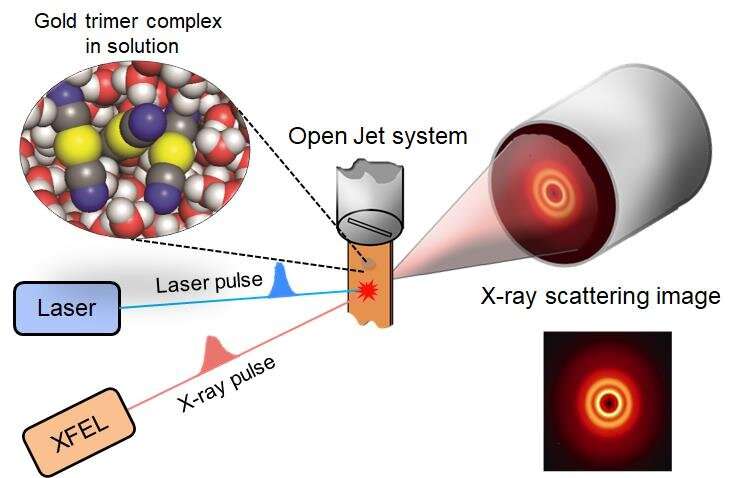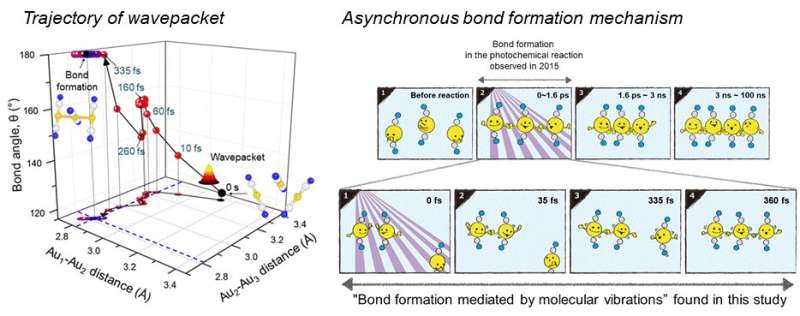The bond formation reaction in a gold trimer complex is initiated by a laser pulse, and a three-dimensional structure after a certain time delay is detected by an x-ray scattering image. Credit: IBS
Targeted cancer drugs work by striking a tight bond between cancer cells and specific molecular targets that are involved in the growth and spread of cancer. Detailed images of such chemical bonding sites or pathways can provide key information necessary for maximizing the efficacy of oncogene treatments. However, atomic movements in a molecule have never been captured in the middle of the action, not even for an extremely simple molecule such as a triatomic molecule, made of only three atoms.
A research team led by Ihee Hyotcherl of the Institute for Basic Science (IBS, South Korea) (Professor, Department of Chemistry, KAIST), in collaboration with scientists at the Institute of Materials Structure Science of KEK (KEK IMSS, Japan), RIKEN (Japan) and Pohang Accelerator Laboratory (PAL, South Korea), reported the direct observation of the birthing moment of chemical bonds by tracking real-time atomic positions in the molecule.
"We finally succeeded in capturing the ongoing reaction process of the chemical bond formation in the gold trimer. The femtosecond-resolution images revealed that such molecular events took place in two separate stages, not simultaneously as previously assumed," says Associate Director Ihee Hyotcherl, the corresponding author of the study. "The atoms in the gold trimer complex remain in motion even after the chemical bonding is complete. The distance between the atoms increased and decreased periodically, exhibiting the molecular vibration. These visualized molecular vibrations allowed us to name the characteristic motion of each observed vibrational mode," adds Ihee.
Atoms move extremely fast at a scale of femtosecond (fs)—quadrillionths of a second. The movement is minute on the level of angstroms, equal to one ten-billionth of a meter. They are especially elusive during the transition state where reaction intermediates are transitioning from reactants to products in a flash. The research team made this experimentally challenging task possible by using femtosecond X-ray liquidography (solution scattering).
This experimental technique combines laser photolysis and X-ray scattering techniques. When a laser pulse strikes the sample, X-rays scatter and initiate the chemical bond formation reaction in the gold trimer complex. Femtosecond X-ray pulses obtained from a special light source called an X-ray free-electron laser (XFEL) were used to interrogate the bond-forming process. The experiments were performed at two XFEL facilities (4th generation linear accelerator), PAL-XFEL in South Korea and SACLA in Japan, and this study was conducted in collaboration with researchers from KEK IMSS, Pohang Accelerator Laboratory (PAL), RIKEN, and the Japan Synchrotron Radiation Research Institute (JASRI).
The movement of three gold atoms measured in this study is shown on the upper left. At 0 fs, the sample was excited by UV light. The table on the upper right shows the measured values of the molecular structure during the photochemical reaction. The horizontal and vertical axes of the 2D graph on the lower left are the distances between gold atoms A-B and B-C, respectively. The points represented by S0 and T1' correspond to the molecular structures before the photochemical reaction and after linear transformation during the reaction process, respectively. The molecular structure changed from S0 to T1' along the red line known as a "reaction path". The 3D graph shown in the lower right was made by adding an energy axis to the 2D graph. The curved surface drawn in the 3D graph is known as a "potential energy surface (PES)". The photochemical reaction is described by the movement of the corresponding position in the 3D graph, and the reaction path can be expected to connect the valleys of the PES. Before UV light excitation, the corresponding position is at the bottom of the PES of S0. When a molecule is excited by UV light, the energy of the molecule is increased, but the molecular structure is still maintained. Therefore, the corresponding position moves vertically in the 3D graph. Then, the molecule structure begins to change with a decrease of its energy, and the corresponding position slides down the PES of T1' along the valley. Finally, the molecular structure becomes linear, and the corresponding position reaches the bottom of the PES of T1'. Until now, to calculate the reaction path, the structural change during a chemical reaction has been discussed. However, in this research, we are able to determine the reaction path without relying on a calculation. Credit: KEK IMSS
Scattered waves from each atom interfere with each other and thus their X-ray scattering images are characterized by specific travel directions. The IBS research team traced real-time positions of the three gold atoms over time by analyzing X-ray scattering images, which are determined by a three-dimensional structure of a molecule. Structural changes in the molecule complex resulted in multiple characteristic scattering images over time. When a molecule is excited by a laser pulse, multiple vibrational quantum states are simultaneously excited. The superposition of several excited vibrational quantum states is called a wave packet. The researchers tracked the wave packet in three-dimensional nuclear coordinates and found that the first half round of chemical bonding was formed within 35 fs after photoexcitation. The second half of the reaction followed within 360 fs to complete the entire reaction dynamics.
(left) Time-dependent positions of the wave packet in the multidimensional nuclear coordinates were obtained from the femtosecond x-ray scattering experiment on a gold trimer complex. (Credit: Nature & IBS) (right) By inspecting the motion of the wave packet, it was revealed that the bond formation reaction in the gold trimer complex occurs through an asynchronous bond formation mechanism. (Yellow: gold atoms, gray: carbon atom, blue: nitrogen atom, 1000 times 1 fs is 1 picosecond (ps), 1000 times 1 ps is 1 nanosecond (ns)) Credit: (left) Nature & IBS, (right) KEK IMSS
The researchers also accurately illustrated molecular vibration motions in both temporally and spatially. This is quite a remarkable feat considering that such an ultrafast speed and a minute length of motion are very challenging conditions for acquiring precise experimental data.
In this study, the IBS research team improved upon their 2015 study published by Nature. In the previous study in 2015, the speed of the X-ray camera (time resolution) was limited to 500 fs, and the molecular structure had already changed to be linear with two chemical bonds within 500 fs. (Figure 2, upper right) In this study, the progress of the bond formation and bent-to-linear structural transformation could be observed in real time, thanks to the improvement time resolution down to 100 fs. Thereby, the asynchronous bond formation mechanism in which two chemical bonds are formed in 35 fs and 360 fs, respectively, and the bent-to-linear transformation completed in 335 fs were visualized (Figure 2, lower right). In short, in addition to observing the beginning and end of chemical reactions, they reported every step of the intermediate, ongoing rearrangement of nuclear configurations with dramatically improved experimental and analytical methods.
The research team will push this method of 'real-time tracking of atomic positions in a molecule and molecular vibration using femtosecond X-ray scattering' to reveal the mechanisms of organic and inorganic catalytic reactions and reactions involving proteins in the human body. "By directly tracking the molecular vibrations and real-time positions of all atoms in a molecule in the middle of reaction, we will be able to uncover mechanisms of various unknown organic and inorganic catalytic reactions and biochemical reactions," says Dr. KIM Jong Goo, the first author of the study.
The study is published in Nature.
More information: Kim, J.G., Nozawa, S., Kim, H. et al. Mapping the emergence of molecular vibrations mediating bond formation. Nature 582, 520–524 (2020). doi.org/10.1038/s41586-020-2417-3
Journal information: Nature
Provided by Institute for Basic Science

























